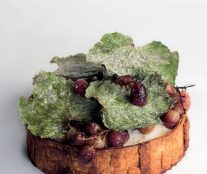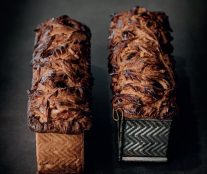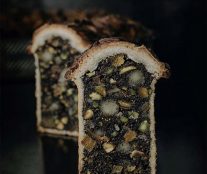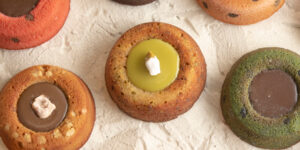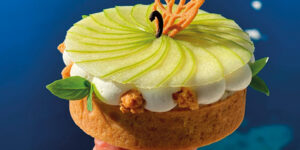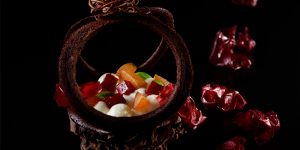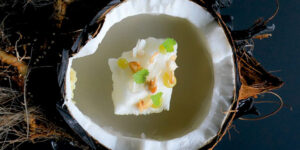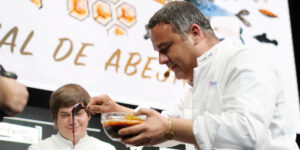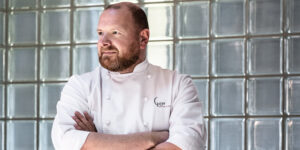Safra with Muhallebi and pine nut and almond dacquoise by Lior Shtaygman
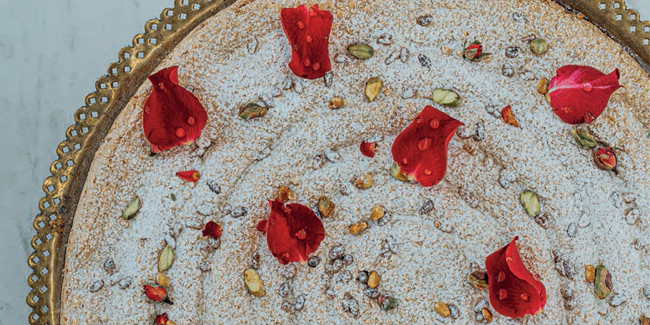
Lior Shtaygman, teacher and manager of the Baking department in Danon – Culinary Institute, located in the port of Tel-Aviv (Israel), is distinguished by his nature-inspired creations. For him, “cakes need to look as if they were grown or created in nature, as if they had developed in an evolutionary way like trees, forests, plants, and in geological forms like valleys and mountains”. Based on this premise, he always tries to make cakes that look like living objects. Something that he more than achieves with his Safra, one of the recipes he shares in so good # 25.
This original semolina cake from Libya takes Shtaygman back to his childhood when his grandmother made it once a year when Yom Kippur, one of the holiest days in the Jewish calendar, is over. As he explains, “it’s a cake we break the fast with, and even though I am not religious and don’t fast, I always look forward to sneaking in and tasting it.”
The Safra is prepared by soaking it in sugar syrup that is mixed with orange blossom water or rose water. It has a characteristic yellow color due to the use of saffron, hence its name. “I also added anise seeds to the Safra; I very much love adding them to pastries,” he adds. In addition, it contains Muhallebi, a creamy milk dessert typical in Arab cuisine that is thickened with corn flour and has a soft, silky texture. On top of the Muhallebi layer, he added a dacquoise biscuit, inspired by French cuisine, which he prepared with pine nuts instead of hazelnuts, which are very popular in France.
“By combining ingredients from different countries, without geographical or political borders, I have created a new dish. I love using the round plate and the spiral shape of the dacquoise with the red rose petals on top. This provides the dish with a festive look that is very typical to the region ”.
Safra
Pine nut and almond dacquoise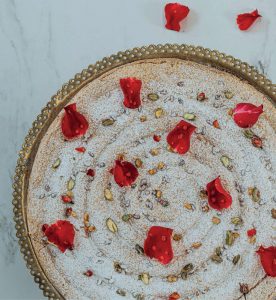
- 300 g egg whites
- 120 g sugar
- 300 g roasted whole almonds
- 300 g icing sugar
- 150 g roasted pine nuts
Using a food processor, blend the icing sugar and whole roasted almonds to a rough meal. Prepare a meringue and fold the almond meal mixture and the roasted pine nuts into it. Pipe the mixture using a pastry bag fitted with a large nozzle into a round baking dish that is lined with some parchment paper, sprinkle icing sugar over the dacquoise and bake in a preheated oven at 170ºC for 25 minutes. Remove from baking dish.
Sugar syrup
- 200 g sugar
- 200 g water
- 5 saffron strands
- q.s. orange blossom water
Combine the sugar, water and saffron and bring to a boil. Remove from the heat and add the orange blossom water as desired.
Safra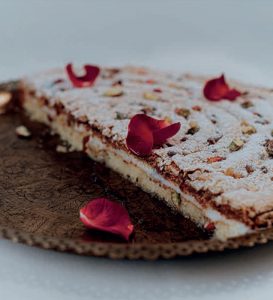
- 135 g sugar
- 200 g eggs
- 120 g butter
- 50 g sunflower oil
- 100 g flour
- 100 g wheat semolina
- 7 g baking powder
- 4 g salt
- 10 g yanson (anise) seeds
Whisk the eggs and sugar, add the melted butter and whisk well, add the oil and mix. Add the rest of the dry ingredients and mix well. Pour into a buttered baking mold and bake for 20 minutes in an oven preheated to 175ºC. Once baked, pour the sugar syrup generously.
Muhallebi
- 700 g milk
- 230 g heavy cream
- 75 g sugar
- 57 g corn flour
- 13 g orange blossom water
Mix the corn flour with a little amount of milk from the recipe until smooth and set aside. Bring the rest of the milk, heavy cream and sugar to a boil. Once boiled, reduce the heat and add the corn flour and milk mixture and boil once again. Remove from the heat and add the orange blossom water. Pour over the semolina cake, previously soaked with the sugar syrup. Spread 150 g of lightly roasted pistachios.
Montage
Use a 35-cm-wide diameter baking dish. Bake the dacquoise, remove from the mold and set aside. Bake the Safra semolina cake and soak with the sugar syrup. Prepare the Muhallebi and pour over the Safra semolina cake. Place the baked dacquoise over the warm Muhallebi and place in the refrigerator. Dust with icing sugar, dried rose petals and pistachios before serving.
